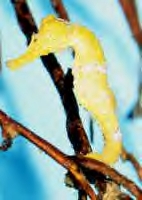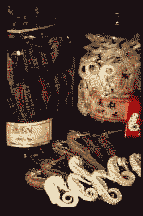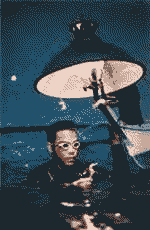|
The capitalized Sea Horses Yes, the sea horse is a quite odd fish. It’s shape provokes quickly associations with other animals. Doesn't it has the head of a horse and the snout of an ant-eater? And don't remind the movable eyes to such of a chameleon, the tail onto certain semi monkeys and the bag of Kangaroos? Other curiosities are coming along. No wonder that already the old Greeks were fascinated by the sea-horse. As mythological figures they pulled the chariot of Poseidon chariots and they guided mermaids. They appear also in the fairytales of the Philippines – first as real noble horses of the Sea-God Amanikables, who transformed them after a rush of dogs in charming sea horses. Today however the dainty creatures run risk of getting boiled to soup- or tea extract and to be put down in the fund of mythological creatures in case of lasting pursuit. We come back to this point.
The classification of species is difficult because of different local names and colour- and sometimes shape-changes of the animals. In general however it is assumed that there are existing approximately 35 species. Whereas the pygmy-species „Hippocampus barganti “ or „Hippocampus minotaur“ hardly reach two centimetres in size, the size of the species “Hippocampus ingens” can reach up to thirty centimetres. The small compressed up righted body is covered with nearly 50 bony plates. The horse like head – carrying a little coronet - is clearly separated from the neck. With the tubular toothless snout the sea horse especially sucks its prey - small shrimps, larvae, crustaceans as well as plankton. The two big eyes move independently.
Seahorses have relatively few natural enemies (penguins, crabs) because of their bony plates. And they are not linked with the human food chain. The different ability of color-change serves for their protection. Frequently, sea horses have a green, beige, light or dark brown basic colour with white stains or strips. There are however species, which can show in adaptation to their environment very quickly blue, orange or crimson colourings. An Australian type has even developed skin-wings, which resemble the vegetation and can cover the body. Sea horses can reach – according to results of aquarium-research – an age between one and six years. Sea horses are unique in the aspect that they have in rule monogamous relationships and that the male animals will guard and nourish the developing embryos. Three to seven days, the pairs woo each another. They dance and embrace intimately themselves with their tails. After the gracile wedding-dance, the female sets aside the eggs into the kangaroo-similar brood- or stomach-bag of the male. The male fertilize the eggs and then the embryos mature in the waterproof bag. depending on species and water-temperature, the pregnancy lasts between ten and forty days. During this time, the female visits the male daily for ten minutes, they have a circling dance. With birth, the male is pressing out of his pocket up to 400 7 - 11 millimetres small mini- sea horses. The small replicas move first to the water-surface and fill their swimming-bladder with air. They are now independent and are not coming back into the brood-bag. An Australian species gives birth seven times a year. We mentioned already that the sea horses are normally pair-bonded for their whole life. If a partner dies or is caught, then the remaining partner stops the reproduction for longer time. After longer time a new partner-searchtakes place. with which the relative location-dependence shapes the partner-search more difficult. This search is difficult because of the relative immobility of the animals. This fact limits strongly the reproduction of the sea horses. The commercial exploitation A cautious estimation, that has official data as basis and excludes more or less the illegal trade, assumes that in the year 2000 the global trade with dried sea horses exceeded more than 70 tons. This amount corresponds - very roughly calculated - a catch-quantity of 24,5 million animals. The dramatic decrease of the wild population is due to an increasing demand of a.) the traditional Chinese medicine, b.) the aquarium fish-trade and c.) the crafts manufacturers.
The majority of
the
sun-bleached sea
horses
are used
as „remedies “. In the
Considerable smaller shares - nevertheless some hundred-thousands of animals - are sold as aquarium fishes. Main-import-countries are the USA and European countries. Hobby-aquarianists especially estimate the smaller, more colored sea horses, for example the yellow-reddish hippocampus barbouri or the orange-colored hippocampus reidi, and are ready to pay 35 US$ and more for captive bred sea horses. The keeping of sea horses is complicated and is recommended only to very experienced aquarianists. Wild-caught sea horses show stress disorders at the beginning of their keeping in aquarium and are difficult to nourish, as they need all four hours a living-feed (shrimps, zooplankton), which is expensive and difficult to get. A lot of animals is dying if they can't find these conditions. The few survivors show a restricted reproduktivity. Sea horses bred in aquariums are more tolerant with regard to pH-content, temperature and water-contamination. They consume also deep-frozen feed. Dried Sea horses are also used as parts of craft products. Then they could be found as amulets, souvenirs for tourists, ornamental jewellery for picture frames, candles, key-chains and paperweights. The Philippine offer The Philippines belong beside India, Vietnam, Thailand and Mexico to the main-export-countries. There is an assumption that approximately one fourth of the world-wide sale-quantity comes from the Philippines. The number the exported animals exceeds more than 5 millions, approximately ninety percent are dried animals. After an estimation of the expert Vincent, 1500 fishers on the Philippines targeted seahorses directly in the late 1990s. Approximately 1700 shrimp fishers sold sea horses as coincidental catches.
Fishers of the place of Handumon report that they could still collect at least fifty animals per night in 1985. From 1985–1995 the harvest dropped however by more than 70 percent. In May 1999, the little amount of round about six Pesos was paid for a dried sea horse. 300 to 450 sea horses amount one kilo. In Cebu, the kilo-price was in this time 2200–2800 Pesos, that corresponds to approximately 55 -70 $, with an assumed rate of exchange of 40 Pesos per dollar. Ten years ago, the kilo-price for dried Sea horse in Hong Kong ranged between 250 U.S. $ for "inferior" small, brown species and 850 U.S. $ for large, bleached species. Living sea horses have been sold for more than 1400 U.S. $/ kg. The "Seahorse"-Project of the Haribon Foundation In order to safeguard the population of sea horses on the Philippines , Dr. Amanda Vincent, a well known Canadian sea horse expert, initiated in 1994 the integrated protection-program "Seahorse" in Handumon. The project has the objective to protect the long-term persistence of sea horses and to develop simultaneously alternative livelihoods for the poor village-community. Other activities are local studies of the biology of the animals, analyses of the world-wide markets and the proceeding of environment-seminars. In cocorporation with local representatives and the majority of the local fishers a 33- hectare reserve was created, in which all fishing is prohibited. Additionally, mangrove-forests were re-established. Pregnant sea horse males are now getting release or are brought into particular network-receptacles until the slipping of the brood. The young descendants can slip through the stitches of the cages while the old animals can be sold after a certain growth-time with a higher price. A little loan, which they got for the caught of pregnant young-fish, can now repaid with help of the higher price. Additionally, further sources of income for the fishers were looked for. They found these in the cultivation of seaweed, establishing of fish-farms, the manufacture of wooden cut-outs or plated (handbags and beach-mats) objects for tourists, and in the eco-tourism. The initiatives have led to an increase of income of the fishers and a higher population of sea horses. Three other villages are following the example of Hanumon. In order to decrease the pressure on wild populations, there have been experiments of breeding seahorses in tanks - even if there is within the traditional Chinese medicine a preference for wild animals. The experiments showed different results. The main-problem is the economic feeding of the sea-horses. It is necessary to get large quantities of certain algaes, to settle the zooplankton, from which the predatory sea horses nourish themselves. In Australia, three generations of the sea-horse species "hippocampus kuda "have been cultivated successfully. Another attempt on Jolo in the year 1992 showed only a survival-quote of twelve percent because of illness of the animals. According to the prevailing opinion lab-born seahorses are too expensive. Dr. Amanda Vincent therefore pleads for a bordered breeding in the natural habitat. Because of the worldwide decline of populations and to provide legal protection to the seahorses a convention was passed in November 2002 in Santiago, Chile. Now all types of sea horses are listed in the appendix II of the „Convention on international Trade in Endangered Species". The obligation to report imports is however only one initially-step in direction of a stronger protection of the sea-horse populations. © Wolfgang Bethge, 2003 |



